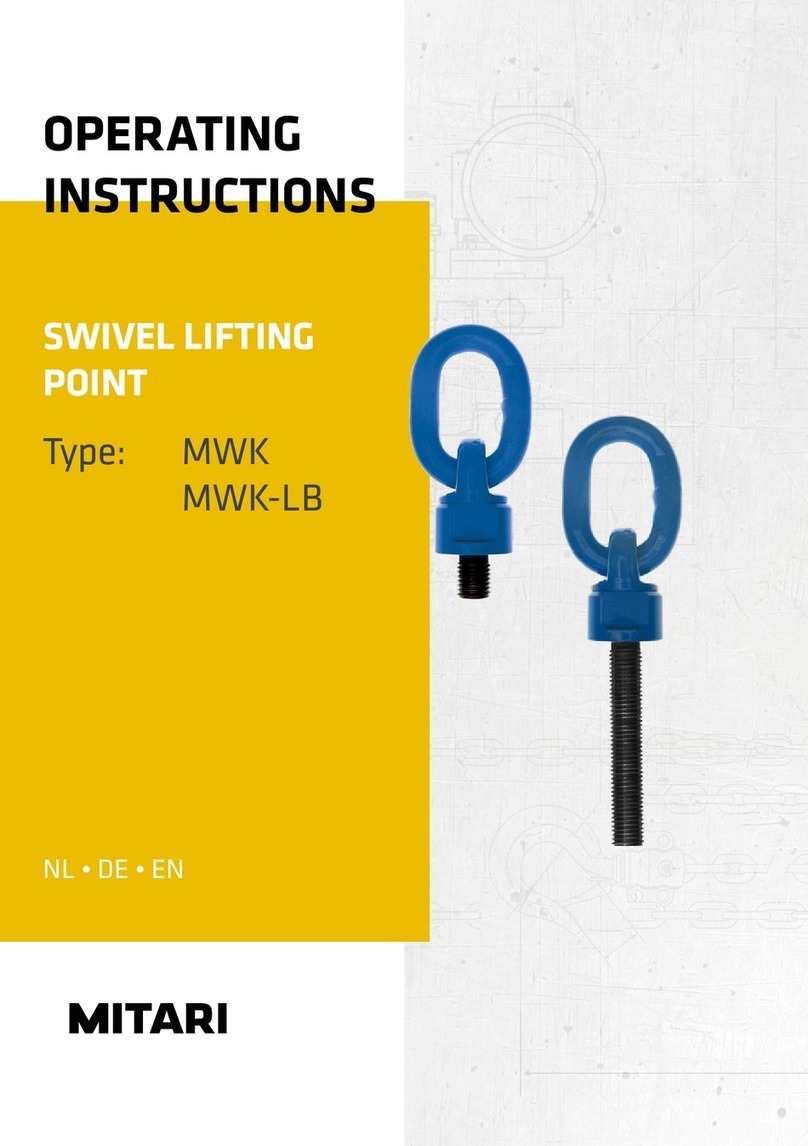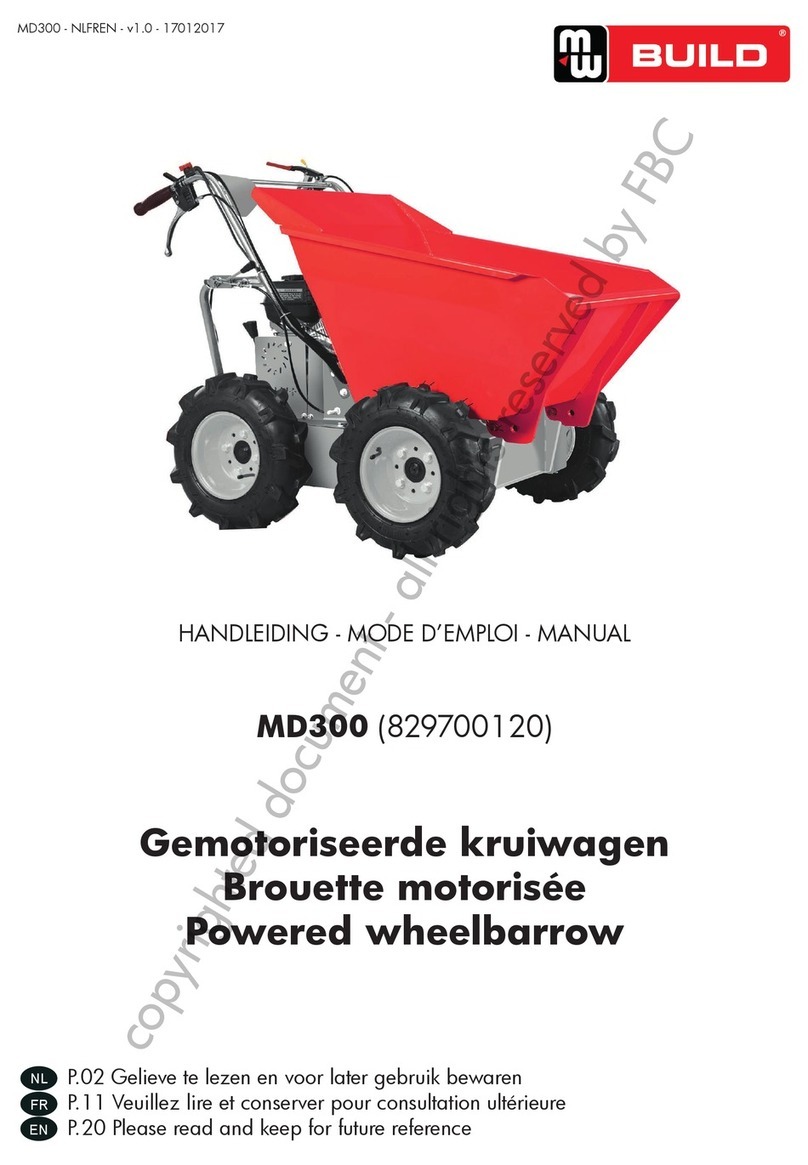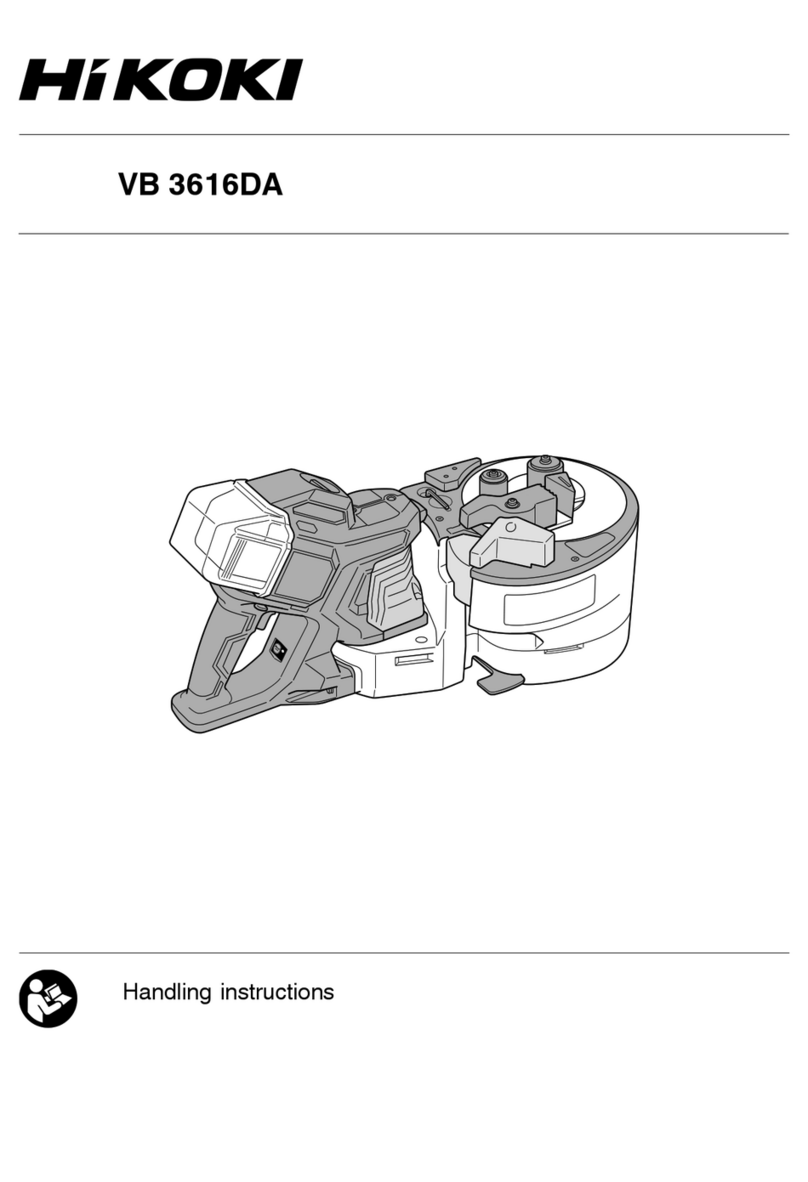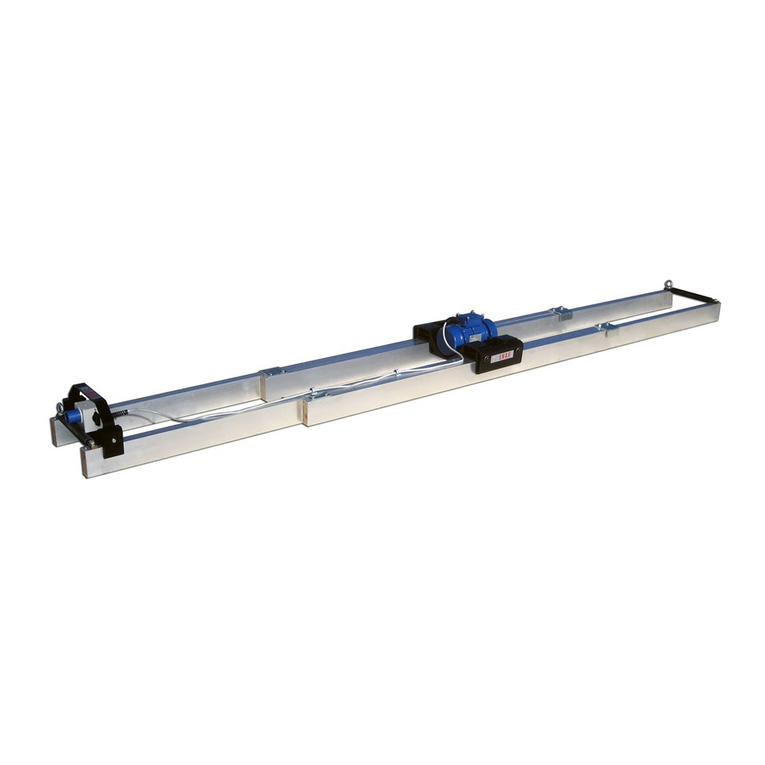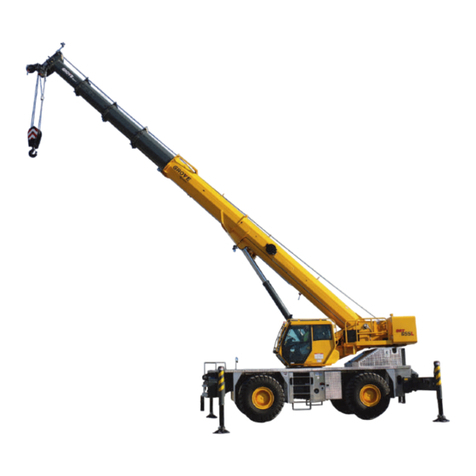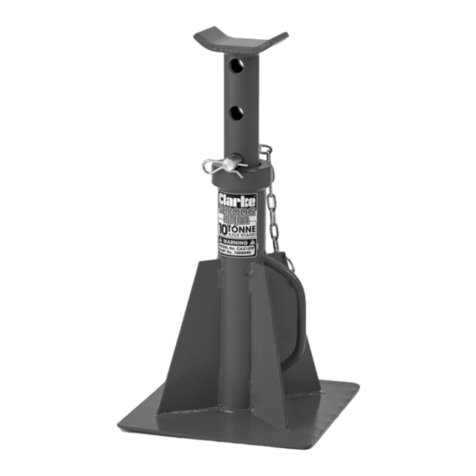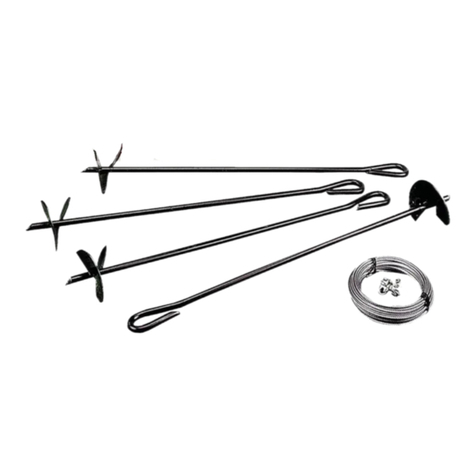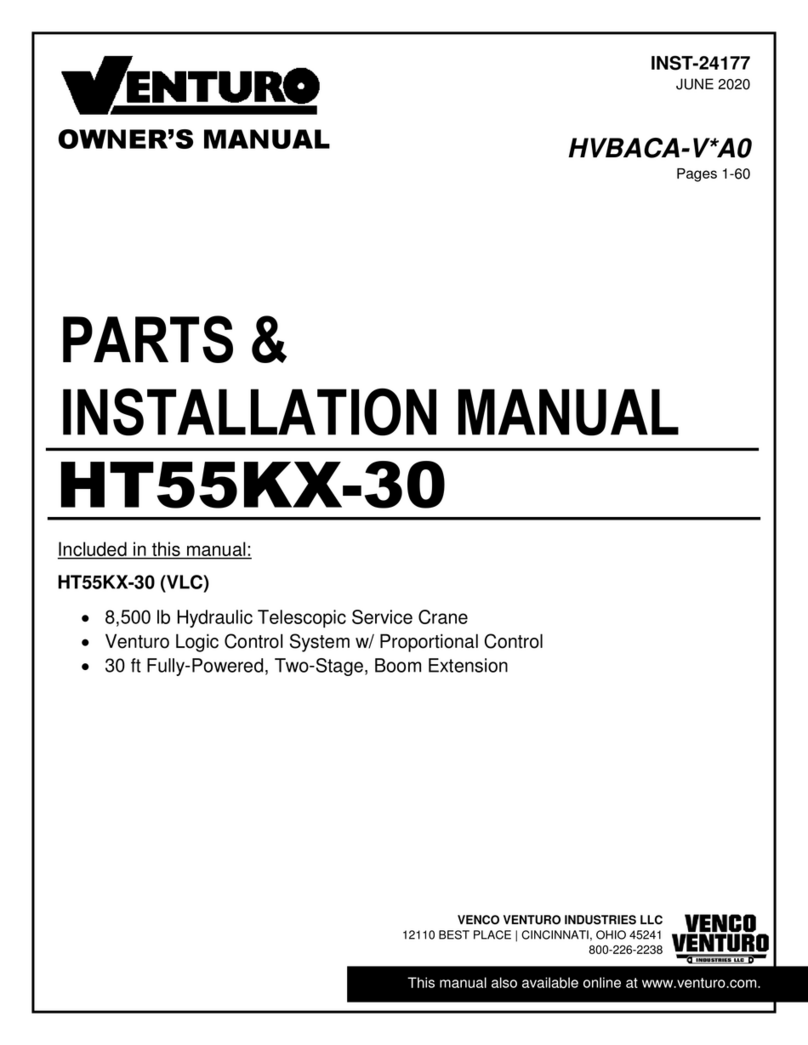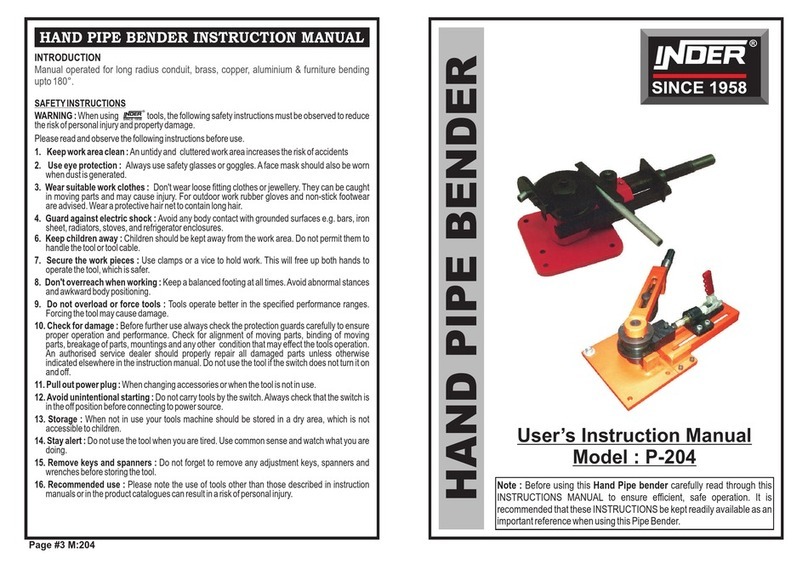CountyLine PHD 100 User manual

ASSEMBLY & OPERATOR’S MANUAL
602378 REV AA
12/18/2018
PHD 100 (602377)
POST HOLE DIGGER
3-POINT MOUNTED
THIS SAFETY ALERT SYMBOL IDENTIFIES IMPORTANT SAFETY MESSAGES IN
THIS MANUAL. FAILURE TO FOLLOW THIS IMPORTANT SAFETY INFORMATION
MAY RESULT IN SERIOUS INJURY OR DEATH.
* Auger sold separately

2 Introduction
Gen’l (Rev. 12/18/2018)
TO THE OWNER:
Read this manual before operating your equipment. The information presented will prepare you to do a better and safer
job. Keep this manual handy for ready reference. Require all operators to read this manual carefully and become
acquainted with all adjustment and operating procedures before attempting to operate. Replacement manuals can be
obtained. Contact SpeeCo, Inc., 4909 SE International Way, Portland, OR 97222, or call 1-800-525-8322.
The equipment you have purchased has been carefully engineered and manufactured to provide dependable and
satisfactory use. Like all mechanical products, it will require cleaning and upkeep. Lubricate the unit as specified.
Observe all safety information in this manual and safety decals on the equipment.
Use only genuine SpeeCo service parts and SAE hardware. Substitute parts will void the warranty and may not meet
standards required for safe and satisfactory operation. Record the model number and serial number of your equipment
in the spaces provided:
Model:
_______________________________
Date of Purchase:
_____________________
Serial Number:
(see Safety Decal section for location) ____________________________________
Provide this information to customer service to obtain correct repair parts.
Throughout this manual, the term NOTICE is used to indicate that failure to observe can cause damage to equipment.
The terms CAUTION, WARNING, and DANGER are used in conjunction with the Safety-Alert Symbol (a triangle with
an exclamation mark) to indicate the degree of hazard for items of personal safety.

Introduction 3
602378 REV AA
12/18/2018
TABLE OF CONTENTS
INTRODUCTION . . . . . . . . . . . . . . . . . . . . . . . . . . . . . . . . . . . . . . . . . . . . . . 2
GENERAL INFORMATION . . . . . . . . . . . . . . . . . . . . . . . . . . . . . . . . . . . . . . 3
SPECIFICATIONS. . . . . . . . . . . . . . . . . . . . . . . . . . . . . . . . . . . . . . . . . . . . . 4
SAFETY RULES . . . . . . . . . . . . . . . . . . . . . . . . . . . . . . . . . . . . . . . . . . . . 5 - 7
SAFETY DECALS . . . . . . . . . . . . . . . . . . . . . . . . . . . . . . . . . . . . . . . . . . . 8 - 9
OPERATION . . . . . . . . . . . . . . . . . . . . . . . . . . . . . . . . . . . . . . . . . . . . . . . . 10
PRE-OPERATION CHECKLIST . . . . . . . . . . . . . . . . . . . . . . . . . . . . . . . . . 13
OWNER SERVICE . . . . . . . . . . . . . . . . . . . . . . . . . . . . . . . . . . . . . . . . . . . 14
TROUBLE SHOOTING . . . . . . . . . . . . . . . . . . . . . . . . . . . . . . . . . . . . . . . . 17
ASSEMBLY INSTRUCTIONS . . . . . . . . . . . . . . . . . . . . . . . . . . . . . . . . . . . 19
BOLT TORQUE CHART . . . . . . . . . . . . . . . . . . . . . . . . . . . . . . . . . . . . . . . 25
BOLT SIZE CHART & ABBREVIATIONS . . . . . . . . . . . . . . . . . . . . . . . . . . 26
GENERAL INFORMATION
■
Some illustrations in this manual show the
digger with safety shields removed to provide a
better view. The digger should never be operated
with any safety shielding removed.
The purpose of this manual is to assist you in operating
and maintaining your post hole digger. Read it carefully.
It furnishes information and instructions that will help
you achieve years of dependable performance. These
instructions have been compiled from extensive field
experience and engineering data. Some information
may be general in nature due to unknown and varying
operating conditions. However, through experience
and these instructions, you should be able to develop
procedures suitable to your particular situation.
The illustrations and data used in this manual were cur-
rent at the time of printing but, due to possible inline
production changes, your machine may vary slightly in
detail. We reserve the right to redesign and change the
machines as may be necessary without notification.
Throughout this manual, references are made to right
and left direction These are determined by standing
behind the equipment facing the direction of forward
travel.
WARNING

4 Introduction 602378 REV AA
12/18/2018
SPECIFICATIONS
ORDERING INFORMATION
Tractor Category Category 1 and Category 2 tractors only
Gear Box
Special alloy pinion gears and tapered roller bearings on both sides of each gear, 540 rpm
Driveline Equipped with quick-tach yoke to fit standard 6 spline PTO (completely shielded)
Augers Sold separately. 6 in., 9 in., 12 in., 18in., and 24in. sizes available
Cutting Edges Sold separately. Replaceable carbide
Point Sold separately. Cast ductile iron, spiral point, replaceable.
Boom 3 in. O.D. high strength tubing
A-frame 3 in. O.D. high strength tubing
Safety Shields On driveline, gear box "U" joint and gear box output shaft
Shear Pin Replaceable. On input shaft to protect driveline, augers, and gears
Options Hydraulic down force kit and weight mounting kit
PART NO. DESCRIPTION
602377 Heavy Duty post hole digger less auger
S24121100 6 in. auger with spiral point and replaceable carbide cutting edges
S24121400 9 in. auger with spiral point and replaceable carbide cutting edges
S24121700 12 in. auger with spiral point and replaceable carbide cutting edges
S24054800 18 in. auger with spiral point and replaceable carbide cutting edges
S24054900 24 in. auger with spiral point and replaceable carbide cutting edges
S24121900 Spiral point 6 in., 9 in., 12 in., 18 in., and 24 in. augers
S24122200 2 in. carbide cutting edge for 6 in., 9 in., 12 in., 18 in., and 24 in. augers
(Quantity required varies by auger size)

Safety 5
TPD SR (2/28/2013)
TRAINING
Safety instructions are important! Read all
attachment and power unit manuals; follow all
safety rules and safety decal information. (Replace-
ment manuals and safety decals are available from
SpeeCo at 1-800-525-8322. Failure to follow instruc-
tions or safety rules can result in serious injury or
death.
If you do not understand any part of this manual
and need assistance, see your dealer.
Know your controls and how to stop engine and
attachment quickly in an emergency.
Operators must be instructed in and be capable
of the safe operation of the equipment, its attach-
ments, and all controls. Do not allow anyone to
operate this equipment without proper instruc-
tions.
Keep hands and body away from pressurized
lines. Use paper or cardboard, not hands or other
body parts to check for leaks. Wear safety goggles.
Hydraulic fluid under pressure can easily penetrate
skin and will cause serious injury or death.
Make sure that all operating and service person-
nel know that if hydraulic fluid penetrates skin, it
must be surgically removed as soon as possible by
a doctor familiar with this form of injury or gan-
grene, serious injury, or death will result.
CONTACT A PHYSICIAN IMMEDIATELY IF FLUID
ENTERS SKIN OR EYES. DO NOT DELAY.
Never allow children or untrained persons to
operate equipment.
PREPARATION
Heavy Components: To avoid muscle strain or
back injury, use lifting aids and proper lifting tech-
niques.
Check that all hardware is properly installed.
Always tighten to torque chart specifications
unless instructed otherwise in this manual.
Always wear relatively tight and belted clothing
to avoid entanglement in moving parts. Wear
sturdy, rough-soled work shoes and protective
equipment for eyes, hair, hands, hearing, and head;
and respirator or filter mask where appropriate.
Make sure attachment is properly secured,
adjusted, and in good operating condition.
Make sure spring-activated locking pin or collar
slides freely and is seated firmly in tractor PTO
spline groove.
Connect PTO driveline directly to power unit
PTO shaft. Never use adapter sleeves or adapter
shafts. Adapters can cause driveline failures due to
incorrect spline or incorrect operating length and
can result in personal injury or death.
Power unit must be equipped with Roll Over
Protection System (ROPS) or ROPS cab and seat
belt. Keep seat belt securely fastened. Falling off
power unit can result in death from being run over
or crushed. Keep foldable ROPS system in “locked
up” position at all times.
Make sure all safety decals are installed.
Replace if damaged. (See Safety Decals section for
location.)
Make sure shields and guards are properly
installed and in good condition. Replace if dam-
aged.
Keep unit from swinging side-to-side by using
stabilizer bars, adjustable sway chains, or sway
blocks on tractor lift arms. Adjust tightly for best
results.
Safety is a primary concern in the design and
manufacture of our products. Unfortunately, our
efforts to provide safe equipment can be wiped
out by an operator’s single careless act.
In addition to the design and configuration of
equipment, hazard control and accident preven-
tion are dependent upon the awareness, con-
cern, judgement, and proper training of
personnel involved in the operation, transport,
maintenance, and storage of equipment.
It has been said, “The best safety device is an
informed, careful operator.” We ask you to be
that kind of operator.
Si no lee Ingles, pida ayuda a
alguien que si lo lea para que le
traduzca las medidas de seguridad.
LEA EL INSTRUCTIVO!
!
SAFETY RULES
ATTENTION! BECOME ALERT! YOUR SAFETY IS INVOLVED!
(Rev. 10/26/2018)

6 Safety
TPD SR (2/28/2013)
OPERATION
Do not allow bystanders within 25 feet of the
area when operating, attaching, removing, assem-
bling, or servicing equipment.
Consult local utilities before digging. Know
location and depth of all underground cables, pipe-
lines, and other hazards in working area and avoid
contact.
Do not put digger into service unless auger
point and all cutting edges are intact and in good
repair.
Do not put digger into service unless all shields
and guards are in place and in good condition.
Replace if damaged.
Keep bystanders away from equipment.
Do not operate or transport equipment while
under the influence of alcohol or drugs.
Operate only in daylight or good artificial light.
Never aim auger point with hands on auger,
gearbox, boom or driveline. To place auger point
use 3-point arms and handle.
Keep hands, feet, hair, and clothing away from
equipment while engine is running. Stay clear of all
moving parts.
Always comply with all state and local lighting
and marking requirements.
Never allow riders on power unit or attachment.
Power unit must be equipped with Roll Over
Protection System (ROPS) or ROPS cab and seat
belt. Keep seat belt securely fastened. Falling off
power unit can result in death from being run over
or crushed. Keep foldable ROPS system in “locked
up” position at all times.
Always sit in power unit seat when operating
controls or starting engine. Securely fasten seat
belt, place transmission in neutral, engage brake,
and ensure all other controls are disengaged
before starting power unit engine.
When digging holes, always sit in operator seat.
To reduce rapid U-joint wear and driveline fail-
ure, never lift auger over 12" from ground when
PTO is running.
Shift tractor transmission into park or neutral
and set brakes before engaging PTO and digging.
Keep digger under control by running PTO at
slowest speed possible (no faster than half-throttle
in 540 rpm range).
Look down and to the rear and make sure area
is clear before traveling in reverse.
Use extreme care when working close to fences,
ditches, other obstructions, or on hillsides.
Do not operate or transport on steep slopes.
When digging in rough ground or hilly terrain,
place digger uphill from tractor. If digger is down-
hill, tractor could tip when pulling auger from hole.
Do not stop, start, or change directions sud-
denly on slopes.
Use extreme care and reduce ground speed on
slopes and rough terrain.
When dislodging a stuck auger, disengage PTO,
stop engine, set parking brake, remove key, dis-
connect PTO from tractor, and turn auger back-
wards with a wrench. Remove and store wrench
before starting engine.
Before performing any service or maintenance,
lower digger to ground or block securely, turn off
tractor engine, remove key, and disconnect drive-
line from tractor PTO.
Never leave a running machine unattended.
Before leaving tractor seat, stop PTO, set brake,
shut off engine, remove key, and let auger come to
a full stop.
MAINTENANCE
Before performing any service or maintenance,
lower digger to ground or block securely, turn off
tractor engine, remove key, and disconnect drive-
line from tractor PTO.
Never go underneath equipment (lowered to the
ground or raised) unless it is properly blocked and
secured. Never place any part of the body under-
neath equipment or between moveable parts even
when the engine has been turned off. Hydraulic
system leak down, hydraulic system failures,
mechanical failures, or movement of control levers
can cause equipment to drop or rotate unexpect-
edly and cause severe injury or death.
Service and maintenance work not covered in
OWNER SERVICE must be done by a qualified
dealership. Special skills, tools, and safety proce-
SAFETY RULES
ATTENTION! BECOME ALERT! YOUR SAFETY IS INVOLVED!

Safety 7
TPD SR (2/28/2013)
dures may be required. Failure to follow these
instructions can result in serious injury or death.
When dislodging a stuck auger, disengage PTO,
stop engine, set parking brake, remove key, dis-
connect PTO from tractor, and turn auger back-
wards with a wrench. Remove and store wrench
before starting engine.
Use a suitable lifting device of sufficient capac-
ity. Use adequate personnel to handle heavy com-
ponents.
Do not modify or alter or permit anyone else to
modify or alter the equipment or any of its compo-
nents in any way.
Never replace shear bolt or auger retaining bolt
with a different length, or grade. Always use a
grade 2 bolt as a replacement.
Always wear relatively tight and belted clothing
to avoid getting caught in moving parts. Wear
sturdy, rough-soled work shoes and protective
equipment for eyes, hair, hands, hearing, and head;
and respirator or filter mask where appropriate.
Do not allow bystanders within 25 feet of the
area when operating, attaching, removing, assem-
bling, or servicing equipment.
Make sure attachment is properly secured,
adjusted, and in good operating condition.
Never perform service or maintenance with
engine running.
Keep all persons away from operator control
area while performing adjustments, service, or
maintenance.
Tighten all bolts, nuts, and screws to torque
chart specifications. Check that all cotter pins are
installed securely to ensure equipment is in a safe
condition before putting unit into service.
Make sure all safety decals are installed.
Replace if damaged. (See Safety Decals section for
location.)
Make sure shields and guards are properly
installed and in good condition. Replace if dam-
aged.
When lubricating telescoping PTO drives, keep
fingers out of shield access slots to prevent injury.
TRANSPORTATION
Always comply with all state and local lighting
and marking requirements.
Never allow riders on power unit or attachment.
Power unit must be equipped with Roll Over
Protection System (ROPS) or ROPS cab and seat
belt. Keep seat belt securely fastened. Falling off
power unit can result in death from being run over
or crushed. Keep foldable ROPS system in “locked
up” position at all times.
Do not operate PTO during transport.
Do not operate auxiliary hydraulics during
transport.
Look down and to the rear and make sure area
is clear before traveling in reverse.
Do not stop, start, or change directions sud-
denly on slopes.
Use extreme care and reduce ground speed on
slopes and rough terrain.
Use additional caution and reduce speed when
under adverse surface conditions, turning, or on
inclines.
Do not operate or transport on steep slopes.
Do not operate or transport equipment while
under the influence of alcohol or drugs.
A minimum 20% of tractor and equipment
weight must be on the tractor front wheels when
attachments are in transport position. Without this
weight, front tractor wheels could raise up result-
ing in loss of steering. The weight may be attained
with front wheel weights, ballast in tires, front trac-
tor weights or front loader. Weigh the tractor and
equipment. Do not estimate.
Raise unit as high as possible for transport.
Reduce transport speed to avoid bouncing and
brief loss of steering control.
STORAGE
Block equipment securely for storage.
Keep children and bystanders away from stor-
age area.
Do not climb or lean on equipment stored on
stand.
SAFETY RULES
ATTENTION! BECOME ALERT! YOUR SAFETY IS INVOLVED!

8 Safety 602378 REV AA
12/18/2018
BE CAREFUL!
Use a clean, damp cloth to clean safety decals. Avoid
spraying too close to decals when using a pressure
washer; high-pressure water can enter through very small
scratches or under edges of decals causing them to peel or
come off. Replacement safety decals can be ordered by
calling customer service at 1-800-525-8322.
PART NUMBER: S52066500
LOCATION: TOP OF BOOM, TRACTOR END
PART NUMBER: S52020100
LOCATION: TOP OF BOOM, GEARBOX END & AUGER TUBE
PART NUMBER: S52020400
LOCATION: BOTH SIDES OF GEARBOX SHIELD
PART NUMBER: 18869
LOCATION: TOP END OF AUGER TUBE
SAFETY & INSTRUCTIONAL DECALS
ATTENTION! BECOME ALERT! YOUR SAFETY IS INVOLVED!
Replace Immediately If Damaged!

Safety 9
602378 REV AA
12/18/2018
PART NUMBER: S52020200
LOCATION: UPPER RIGHT SIDE OF BOOM PART NUMBER: S52056400
LOCATION: TOP OF BOOM, TRACTOR END
PART NUMBER: S52020300
LOCATION: BOTH SIDES OF GEARBOX SHIELD
PART NUMBER: S52019200
LOCATION: PTO DRIVE SHAFT SHIELD
SAFETY & INSTRUCTIONAL DECALS
ATTENTION! BECOME ALERT! YOUR SAFETY IS INVOLVED!
Replace Immediately If Damaged!

10 Operation 602378 REV AA
12/18/2018
OPERATION
The post hole digger and its individual components are
NOT to be used for anything other than their intended
use. The operator is responsible for the safe operation
of the equipment. The operator must be properly
trained. Operators should be familiar with the equip-
ment, the tractor, and all safety practices before start-
ing operation. Read the safety rules and safety decals
on page 5 to page 9.
Post hole diggers are designed for one-man operation.
You must always dig holes while sitting in the tractor
seat. It is the responsibility of the operator to see
that no one else is within twenty-five feet (25’) of
the digger when it is operating. Accidents have
occurred when more than one person is in the immedi-
ate area of the operating equipment. Be sure no one
else is near you when you operate this product.
Do not put digger into service unless all shields
and guards are in place and in good condition.
Replace if damaged.
Never aim auger point with hands on auger,
gearbox, boom or driveline. To place auger point
use 3-point arms and handle.
Do not shovel dirt away from a running auger.
The shovel could be caught and thrown by auger.
Consult local utilities before working. Know
location of all underground cables, pipelines, over-
head wires, and other hazards in working area and
avoid contact.
When dislodging a stuck auger, disengage PTO,
stop engine, set parking brake, remove key, dis-
connect PTO from tractor, and turn auger back-
wards with a wrench. Remove and store wrench
before starting engine.
Keep hands, feet, hair, and clothing away from
equipment while engine is running. Stay clear of all
moving parts.
Keep hands and body away from pressurized
lines. Use paper or cardboard, not hands or other
body parts to check for leaks. Wear safety goggles.
Hydraulic fluid under pressure can easily penetrate
skin and will cause serious injury or death.
Make sure that all operating and service person-
nel know that if hydraulic fluid penetrates skin, it
must be surgically removed as soon as possible by
a doctor familiar with this form of injury or gan-
grene, serious injury, or death will result.
CONTACT A PHYSICIAN IMMEDIATELY IF FLUID
ENTERS SKIN OR EYES. DO NOT DELAY.
Do not put digger into service unless auger
point and all cutting edges are intact and in good
repair.
Keep bystanders away from equipment.
Shift tractor transmission into park or neutral
and set brakes before engaging PTO and digging.
Keep digger under control by running PTO at
slowest speed possible (no faster than half-throttle
in 540 rpm range).
Always wear relatively tight and belted clothing
to avoid getting caught in moving parts. Wear
sturdy, rough-soled work shoes and protective
equipment for eyes, hair, hands, hearing, and head;
and respirator or filter mask where appropriate.
Tighten all bolts, nuts, and screws to torque
chart specifications. Check that all cotter pins are
installed securely to ensure equipment is in a safe
condition before putting unit into service.
When digging holes, always sit in operator seat.
IMPORTANT
Never exceed the recommended auger capacity
of the post hole digger. Use of an incorrect auger
or auger extension can cause equipment damage,
loss of operator control and personal injury. See
specifications on page 4 for available auger capaci-
ties.
PREPARATION
Thoroughly read and understand your Operator’s Man-
uals.
Before beginning operation, clear area of objects that
wrap around the auger or might be thrown.
Contact local utility company to make certain there are
no buried gas lines, electrical cables, etc., in the work
area.
Check for ditches, stumps, holes, or other obstacles
that could cause the tractor to roll.
DANGER
WARNING
WARNING
CAUTION

Operation 11
602378 REV AA
12/18/2018
To dig properly, your digger must be able to raise or
lower through the highest and lowest points of your lift
arm travel without binding against the tractor frame.
Check carefully BEFORE attaching the auger. If it does
bind, adjust the tractor 3-pt. linkage so that all move-
ment is free.
Use stabilizer bars, adjustable sway chains, or sway
blocks on your tractor lift arms to keep the post hole
digger from swaying side to side. Adjust as tightly as
practical for best performance. Remove or place tractor
drawbar in storage position.
IMPORTANT
■
Post hole digger gearboxes are shipped with-
out lubrication. Gearboxes must be serviced with
90W gear lube before operation.
■
If PTO driveline interferes with swinging draw-
bar, swing drawbar out of the way or remove.
OPERATING TECHNIQUE
Never aim auger point with hands on auger,
gearbox, boom or driveline. To place auger point
use 3-point arms and handle.
Do not shovel dirt away from a running auger.
The shovel could be caught and thrown by auger.
IMPORTANT
■
NEVER use body weight to help the auger
penetrate the ground.
1. Position the tractor so that the auger point is
placed where the hole is to be dug.
2. Set tractor brakes. Shift transmission into park or
neutral.
3. Do not allow anyone to stand within 25 ft of the
auger during operation.
4. Lower auger point slowly to the ground with the
PTO disengaged.
The point of the auger should be approximately 3" back
of center of the gearbox. As the auger works into the
ground, this slight angle will straighten, due to the piv-
oting action of the boom downward. If the auger has a
side tilt, correct with the lift arm adjustment on the trac-
tor hitch.
If the auger tilts too far forward or to the rear, it may be
necessary to move the tractor slightly. Be careful not to
bend the auger.
With the auger point lowered to the ground, set the
engine speed to idle, then engage the PTO. Make sure
the auger point is on the ground before engaging the
PTO.
IMPORTANT
■
Under no circumstances should the PTO be
run in excess of 540 RPM.
As the auger penetrates the ground, lower the unit
slowly with the 3-point lift arms. Do not let the auger
screw itself into the ground! Auger must dig with the
dirt breaking up and being carried to the top by the
auger flighting.
Figure 1. Operation
Dig the hole in small steps. Dig down several inches,
then bring the auger up to let the soil clear. Repeat this
procedure until the desired depth is reached. This
allows better control of the auger and can prevent diffi-
culties that could lead to an accident.
IMPORTANT
■
Be careful when raising the auger as high as
your tractor’s 3-point lift arms can go. This can put
the PTO shaft universal joints at an extreme angle
and cause damage to the PTO shaft! It is best to
raise the auger just enough to clear the hole when
the PTO is engaged.
■
It is recommended NOT to raise the auger
more than six (6) inches above the ground while it
is running. Once the hole is dug to the desired
depth raise the auger while rotating to bring the dirt
out of the hole.
To get a clean hole, it is sometimes best to lower the
auger into the hole with the auger turning and then,
when at the bottom, stop the rotation and raise the
auger while not turning. This brings the dirt up with little
left in the hole.
Disengage the PTO when traveling between holes.
In some types of soil it may be necessary to use the 3-
point lift arms to prevent the auger from screwing itself
into the ground.
WARNING

12 Operation 602378 REV AA
12/18/2018
When the ground is too tough to penetrate with your
cutting edges and point, sharpen or replace them and
try again. These are replaceable parts and must be in
good condition to penetrate. (An optional Hydraulic
Down Pressure Kit is available.)
If you have difficulty penetrating hard ground, refer to
the Troubleshooting section in this manual for sugges-
tions.
DOWN FORCE KIT OPERATION
(OPTIONAL)
IMPORTANT
■
Do not connect RETURN hose to a remote
outlet. Remote outlet ports are blocked in the neu-
tral position and will damage the hydraulic cylinder
when boom is raised.
1. Lower post hole digger using the 3-point arms and
allow auger to dig.
2. If down force is required, slowly apply down force
using the control lever for the remote outlet. Apply
force in small amounts.
3. Continue to lower the auger using the tractor 3-
point lift arms as the auger digs.
4. Raise auger with the 3-point lift arms. Cylinder will
retract when auger is raised out of the hole.
TRANSPORT
Do not operate PTO during transport.
The post hole digger auger is free-swinging, and care
should be taken while transporting the machine.
Be sure auger is completely retracted from the hole
before attempting to move the tractor.
DO NOT transport the post hole digger while the PTO
is engaged as this could cause the universal joints of
the PTO driveline into a sharp operating angle and
cause failure of the driveline.
Pay particular close attention to the Safety Messages
regarding transport. Avoid unnecessary injuries and
equipment damage by exercising cautious, conscien-
tious travel procedures.
Attaching the implement to the tractor increases the
overall length of the working unit. Allow additional
clearance for the implement to swing when turning.
Raise the implement as high as possible for transport-
ing.
LODGED AUGER
When dislodging a stuck auger, disengage PTO,
stop engine, set parking brake, remove key, dis-
connect PTO from tractor, and turn auger back-
wards with a wrench. Remove and store wrench
before starting engine.
■
Removing a lodged auger can be dangerous
work. Be careful.
1. If the auger gets stuck in wet clay, stones or roots,
disengage the PTO immediately and turn off the
engine.
2. Turn the auger backwards several turns with a
large pipe wrench. Then attempt to raise the auger
with the 3-point lift arms. Extreme rocking or lifting
loads while trying to clear auger can cause auger,
gearbox, or boom failure.
NOTE: Do not attempt to raise the auger while
turning it with a wrench or with a wrench attached
to the auger. You could be injured if the PTO was
accidently engaged or the 3-point lift arms sud-
denly raised the auger.
3. Remove and store wrench before starting engine.
Figure 2. Dislodge Auger
WARNING
WARNING

Operation 13
602378 REV AA
12/18/2018
SHEAR BOLT REPLACEMENT
Never replace shear bolt or auger retaining bolt
with a different length, or grade. Always use a
grade 2 bolt as a replacement.
Shear bolts are important for both safety and prevent-
ing damage to the digger. Their intended function is to
break when too much force is applied.
Always replace shear bolts at the gearbox input with
manufacturer's part or one of the same size, length and
SAE Grade 2 specification.
Hardened bolts or bolts that are too long can cause
accidents resulting in injury or death.
The set screw, Figure 3, prevents the driveline from
coming off gearbox shaft if the shear bolt should shear.
Figure 3. Shear Bolt Replacement
PRE-OPERATION CHECKLIST
___ Review and follow all safety rules and safety
decal instructions on pages 5 through 9.
___ Check that all safety decals are installed and in
good condition. Replace if damaged.
___ Check that all shields and guards are properly
installed and in good condition. Replace if dam-
aged.
___ Consult local utilities before digging. Know loca-
tion of and avoid contacting all underground
cables, pipelines, overhead wires and other haz-
ards in digging area.
___ Check that auger point and all cutting edges are
intact and in good repair.
___ Check that equipment is properly and securely
attached to tractor.
___ Make sure driveline spring-activated locking pin
slides freely and is seated firmly in tractor PTO
spline groove or gearbox PTO spline groove.
___ Set tractor PTO at correct rpm for your equip-
ment.
___ Check all lubrication points and grease as
instructed in “Service, lubrication information.”
___ Lubricate all grease fitting locations. Make sure
telescoping PTO shafts and universal joints are
lubricated.
___ Check that all hydraulic hoses and fittings are in
good condition and not leaking before starting
tractor. Check that hoses are not twisted, bent
sharply, kinked, frayed or pulled tight. Replace
any damaged hoses immediately.
___ Make sure tractor 3-point lift links do not interfere
with hydraulic hoses or driveline throughout full
turning range.
___ Check that all hardware and cotter pins are prop-
erly installed and secured.
___ Check attitude adjustment of auger.
___ Check and keep all bystanders 25 ft away from
equipment working area.
___ Before starting engine, operator must be in trac-
tor seat with seat belt fastened. Place transmis-
sion in neutral or park, engage brake and
disengage tractor PTO.
WARNING
1. Gearbox
2. Driveline
3. M6 x 25 set screw
4. M6 jam nut
5. 3/8 NC x 3 grade 2 shear bolt
6. 3/8 lock washer
7. 3/8 NC hex nut
*Input shield
removed for detail

14 Owner Service 602378 REV AA
12/18/2018
OWNER SERVICE
The information in this section is written for operators
who possess basic mechanical skills. For your protec-
tion, read and follow all safety information in this man-
ual.
Before performing any service or maintenance,
lower digger to ground or block securely, turn off
tractor engine, remove key, and disconnect drive-
line from tractor PTO.
NEVER GO UNDERNEATH EQUIPMENT. Never
place any part of the body underneath equipment
or between moveable parts even when the engine
has been turned off. Hydraulic system leak-down,
hydraulic system failures, mechanical failures, or
movement of control levers can cause equipment
to drop or rotate unexpectedly and cause severe
injury or death.
• Service work does not require going under-
neath implement.
• Read Operator's Manual for service instruc-
tions or have service performed by a qualified
dealer.
Keep all persons away from operator control
area while performing adjustments, service, or
maintenance.
Keep hands, feet, hair, and clothing away from
equipment while engine is running. Stay clear of all
moving parts.
Keep hands and body away from pressurized
lines. Use paper or cardboard, not hands or other
body parts to check for leaks. Wear safety goggles.
Hydraulic fluid under pressure can easily penetrate
skin and will cause serious injury or death.
Make sure that all operating and service person-
nel know that if hydraulic fluid penetrates skin, it
must be surgically removed as soon as possible by
a doctor familiar with this form of injury or gan-
grene, serious injury, or death will result.
CONTACT A PHYSICIAN IMMEDIATELY IF FLUID
ENTERS SKIN OR EYES. DO NOT DELAY.
Always wear relatively tight and belted clothing
to avoid getting caught in moving parts. Wear
sturdy, rough-soled work shoes and protective
equipment for eyes, hair, hands, hearing, and head;
and respirator or filter mask where appropriate.
ROUTINE MAINTENANCE
1. Check that all bolts, nuts, and screws are tight.
Checking the bolts and nuts on the cutting blades
is particularly important in rocky soil.
2. Check daily the level of the gearbox oil and top-off
up to the correct level. Check for gearbox oil leaks.
It should be noted that no warranty claim can be
submitted on a gearbox that has run dry. It is
essential that the gearbox is kept correctly filled
with gearbox oil.
3. Grease the PTO shaft daily.
4. Check the wear on the cutting blades. Sharpen
them routinely with an angle grinder or replace
when worn down too far. Keep at least two sets of
cutting blades, bolts, and nuts as spares.
LUBRICATION INFORMATION
When lubricating telescoping PTO drives, keep
fingers out of shield access slots to prevent injury.
The accompanying chart gives the frequency of lubri-
cation in operating hours, based on normal conditions.
Severe or unusual conditions may require more fre-
quent lubrication.
Do not let excess grease collect on or around parts,
particularly when operating in sandy areas.
Use an SAE 90W gear lube in gearbox.
Use a lithium grease of No. 2 consistency with a MOLY
(molybdenum disulfide) additive for all locations. Be
sure to clean fittings thoroughly before attaching
grease gun. When applied according to the lubrication
chart, one good pump of most guns is sufficient. Do not
over grease.
LUBRICATION CHART
WARNING
WARNING
CAUTION
Ref. No. Description Frequency
1 Front U-Joint 8 Hours
2 Rear U-Joint 8 Hours
3 Rear U-Joint to
Input Shaft Seasonally
4Gearbox
(Fill to proper level) Check Daily
CAUTION

Owner Service 15
602378 REV AA
12/18/2018
Daily lubrication of the PTO slip joint is necessary. Fail-
ure to maintain proper lubrication can result in damage
to U-joints, gearbox, tractor PTO and/or driveline.
STORAGE
1. Drain and change the oil in your gearbox.
2. Check and replace, where necessary, blades,
bolts, nuts on the machine.
3. Clean machine and touch up any rust spots that
may have appeared.
4. Replace any safety decals if damaged, illegible, or
painted over.
5. Make sure PTO driveline yoke and gearbox input
shaft are clean and free of burrs. Keep well
lubricated to prevent galling of yoke and input shaft
when shear bolt becomes sheared.
6. Keep all shields in place. Order new shields if
damaged or missing.
7. Keep cutting edges sharp. Sharp cutting edges dig
easier and better. Outer cutting edges on larger
augers wear faster than inner cutting edges;
switching teeth will even wear.
8. Store implement in clean, dry location.
REMOVE DIGGER FROM TRACTOR
When off the tractor, post hole diggers can be an awk-
ward piece of equipment to handle. Be careful not to
pinch hands and fingers in the various hinge points of
the digger.
INSTALL PARKING STAND
Figure 4. Parking Stand Installation
1. Raise digger to the transport position.
2. Insert the two stand legs (4) into the lug (2) on the
front of the output shield. Secure with two locking
pins (3).
3. Lower digger until the two legs and the auger form
a tripod. This will support the post hole digger in a
vertical position.
4. Remove 3-point arms and driveline from the
tractor.
5. Hang the PTO end of the driveline over the PTO
shaft storage bracket to help prevent dirt and
debris from accumulating in the locking collar on
the driveline PTO yoke.
Alternative Suggestions
If available, the digger can be hung from an overhead
rafter or beam. Attach the chain or rope around the
boom just ahead of the gearbox. This allows one man
to easily reconnect the digger to the tractor when next
use is required.
If storing outside, another idea is to dig a hole about
12-18 inches deep. Then shut the PTO off while the
auger is in the hole. Set parking brake, turn off engine,
and disconnect the digger from the tractor. The auger
in the hole will keep the unit upright and make it possi-
ble for one person to disconnect or reconnect to the
1. Auger
2. Gearbox output shield lug
3. 5/16 x 1-3/8 lock pin
4. Parking stand leg

16 Owner Service 602378 REV AA
12/18/2018
tractor. Doing this, will cause rusting of the auger, but it
is easy for one person to handle the unit.
REPLACE CUTTING EDGE
Cutting edges and center points are replaceable. They
should be sharpened or replaced when worn.
1. Remove carriage bolt (4), lock washer (5), and hex
nut (6) holding cutting tooth to the auger.
2. Replace or sharpen cutting tooth. Install carriage
bolt, lock washer, and hex nut previously removed.
3. Remove center point (1) by removing cap screw
(3), lock washer (5), and hex nut (6).
Figure 5. Cutting Tooth Replacement
POST HOLE DIGGER OPTION
(HYDRAULIC DOWN FORCE KIT)
For tough, hard soil conditions. This will allow operator
to put 300-400 lbs. of down force on the auger to force
cutting edges into tough or hard ground. Tractor must
have auxiliary hydraulic outlet. Contact your place of
purchase for more information.
CLEAN POST HOLE DIGGER
After Each Use
●
Remove large debris such as clumps of dirt, grass,
crop residue, etc. from machine.
●
Inspect machine and replace worn or damaged
parts.
●
Replace any safety decals that are missing or not
readable.
Periodically or Before Extended Storage
●
Clean large debris such as clumps of dirt, grass,
crop residue, etc. from machine.
●
Remove the remainder using a low-pressure water
spray.
1. Be careful when spraying near scratched or torn
safety decals or near edges of decals as water
spray can peel decal off surface.
2. Be careful when spraying near chipped or
scratched paint as water spray can lift paint.
3. If a pressure washer is used, follow the advice
of the pressure washer manufacturer.

Troubleshooting 17
602378 REV AA
12/18/2018
TROUBLESHOOTING
PROBLEM POSSIBLE CAUSES & SOLUTION
Auger will not dig Shear bolt sheared – install new shear bolt.
Teeth dull – sharpen or replace.
Ground too dry and hard – order optional down force kit, or wait until it
rains.
Auger turning too fast and bouncing – reduce speed.
Tall grass has wrapped around auger teeth – remove grass.
Auger encountering rocks, roots, or other obstruction – lift auger from hole
and inspect.
Auger teeth improperly positioned – see Parts section in this manual for
proper tooth pattern.
Post hole digger sways side to side No sway bars or sway blocks on tractor – add some.
Lift arms not adjusted evenly – adjust lift arms.
Post hole digger is mounted with excessive looseness in the hitch
connecting points – use proper size pins or bushings.
Bent auger flighting or bent auger Tractor moved while auger was turning in hole – always set brakes on
tractor and make sure it is out of gear.
Operator moved tractor with auger in hole to try and straighten a hole
being dug at an angle.
Auger is encountering rocks or roots or other foreign objects – remove
object from hole or change location.
Outer edge of auger flighting is bending due to contact with rocks or roots
– use heavy-duty auger with thicker flighting.
Shear bolt has been replaced with harder bolt – replace with Grade 2 bolt
per instructions.
Auger screws itself into the ground Operator did NOT ease 3-point hitch to ground slowly.
Tractor 3-point does not have position control. Lift auger after advancing
every 3" - 4".
Faulty 3-point hitch hydraulic system on tractor.
Draft control is not in OFF position.
Tractor is too small to handle digger.
Excessive vibration PTO driveline bearing cross is worn – replace.
PTO driveline assembly comes off
input shaft of gearbox when shear
bolt is sheared
Set screw missing in yoke at gearbox input shaft. Install set screw as per
driveline installation instructions. THIS IS A DANGEROUS SAFETY
HAZARD, CORRECT IMMEDIATELY!
Auger digs so far, but will not dig
deeper
See solutions for above.
PTO assembly “bottoms out,” not allowing digger to lower – remove auger
from digger and lower digger. Gearbox should lower to the ground; if not,
PTO driveline assembly may need to be shortened.
PTO driveline interferes with swinging drawbar – swing drawbar out of the
way or remove.
Tractor hydraulic system may be faulty – consult tractor dealer.
Soil could have hardpan layer 6"-10" below surface – use optional down
force kit (see list of optional equipment).

18 Troubleshooting 602378 REV AA
12/18/2018
TROUBLESHOOTING
PROBLEM POSSIBLE CAUSES & SOLUTION
PTO driveline failure Operator raising post hole digger too high above ground when PTO is
engaged – causes excessive PTO joint operating angle.
PTO is engaged while moving between holes. (Auger swings, which
causes excessive PTO joint operating angle.)
Improper use of a hard shear bolt – use Grade 2 bolt per instructions.
Driveline has not been properly lubricated.
Engaging tractor PTO with engine at high rpm.
Digging holes too deep so that PTO driveline contacts ground.
Operating at high rpm.
Use of auger extension can require post hole digger to be lifted high,
which can cause excessive PTO joint operating angle.
PTO driveline “galls” or “friction
welds” to input shaft of gearbox
Tractor is a “low profile model” (one that is low to the ground). Due to the
low height of the tractor, the digger must be raised higher to have the
bottom of the auger clear the ground. Generally, low profile model tractors
can only use 30" long augers (standard auger length is 42"). Use a
different tractor or purchase 30" long augers.
No lubrication on input shaft of gearbox to allow yoke of PTO driveline to
turn freely on input shaft when shear bolt is sheared. Always keep input
shaft greased.
Gearbox failure No oil in gearbox.
Oil not changed per instructions.
Shear bolt has been replaced with a harder bolt – replace with Grade 2
per instructions.
Bent output shaft is due to operator moving tractor when auger is in hole.
Gearbox overheating Low on lubricant – fill to proper level.
Improper type lubricant – replace with proper lubricant.
Auger bolts shear on gearbox
output shaft
Shear bolt on input shaft has been replaced with a harder bolt – replace
with Grade 2 bolt as per instructions.
Tractor stalls Auger is encountering rocks or roots or other foreign object – remove
object or change hole location.
Tractor idle is not set correctly – tune tractor engine.

Assembly 19
602378 REV AA
12/18/2018
ASSEMBLY INSTRUCTIONS
Keep hands, feet, hair, and clothing away from
equipment while engine is running. Stay clear of all
moving parts.
Keep all persons away from operator control
area while performing adjustments, service, or
maintenance.
Make sure spring-activated locking pin or collar
slides freely and is seated firmly in tractor PTO
spline groove.
Always wear relatively tight and belted clothing
to avoid getting caught in moving parts. Wear
sturdy, rough-soled work shoes and protective
equipment for eyes, hair, hands, hearing, and head;
and respirator or filter mask where appropriate.
Heavy Components: To avoid muscle strain or
back injury, use lifting aids and proper lifting tech-
niques.
Failure to follow instructions in this manual can
result in injury.
SET-UP INSTRUCTIONS
The digger is shipped partially assembled. Assembly
will be easier if the components are aligned and loosely
assembled before tightening hardware. Recommended
torque values for hardware are located on page 26.
Select a suitable working area. Uncrate parts boxes
and lay out parts and hardware to make location easy.
Refer to illustrations, accompanying text, parts lists and
exploded view drawings.
IMPORTANT
■
Post hole digger gearboxes are shipped with-
out lubrication. Gearboxes must be serviced with
90W gear lube before operation.
ATTACH A-FRAME AND BOOM TO TRACTOR
A tractor is required during assembly of post hole dig-
ger. A tractor will make part fit-up, part alignment, and
part handling easier.
1. Connect lift arm pins (6), Figure 1, and hardware
supplied with pins to the A-frame assembly (2).
Mount PTO shaft storage bracket as shown on
outside of A-Frame.
NOTE: On tractors with 3-point arm spacing of 32
inches, place mounting pins on the outside of the
yoke assembly. On tractors with 3-point arm spac-
ing of 26 inches or less, place mounting pins on the
inside of the yoke assembly.
2. Connect A-frame assembly to the tractor 3-point
arms.
3. Attach boom (1) to the tractor top link bracket..
4. Align A-frame assembly with the adjustment
channel on the boom, starting with the second
hole. Secure into position using boom adjustment
pin (3) and lynch pin (5).
IMPORTANT
With boom attached to tractor, raise boom by
hand. Check clearance between boom and top link
bracket. If interference exists, change hole location
and recheck. Failure to check can result in damage
to the tractor or boom.
Figure 1. A-Frame to Boom Assembly
WARNING
CAUTION
1. Boom
2. A-frame
3. Top link pin
4. Lynch pin
5. PTO shaft storage bracket
6. 7/8-14 NF x 6.78 lift arm pin
7. 7/8 NF jam nut
8. 7/8 lock washer
9. 7/8 NF hex nut

20 Assembly 602378 REV AA
12/18/2018
ATTACH GEARBOX TO BOOM
1. Place gearbox on level section of ground resting on
output shaft shield.
2. Lower boom and align gearbox mount holes with
boom mount hole.
3. Secure gearbox to boom using the supplied pin (4)
and cotter pins (3).
Figure 2. Gearbox to Boom Installation
ATTACH AUGER TO GEARBOX
1. Raise boom (1), allowing enough space to install
auger.
2. Slide auger over gearbox output shaft and install
1/2 bolt (3), 1/2 lock washer (4), and 1/2 nut (5) in
both hole locations. Tighten all hardware.
Figure 3. Auger to Gearbox Installation
INSTALL DRIVELINE
Figure 4. Driveline Installation
1. Clean input shaft on gearbox and smooth bore of
driveline yoke. Remove any foreign material or
paint. Lightly file any nicks or dents.
2. Grease the input shaft of the gearbox. This
reduces the chance of the driveline galling the
shaft if the shear bolt should fail.
3. Slide driveline over input shaft and align cross
holes. Insert shear bolt (3) to hold parts together.
4. Loosen the jam nut (6) so that it is flush with the top
of the set screw (7, Fig 3.1). Tighten the set screw
against the gearbox input shaft. Once tightened,
loosen the set screw (7) a 1/4 turn. Continue to
hold the set screw (7) in this position while
tightening the jam nut (6). Remove shear bolt (3)
from cross hole. Driveline yoke should spin freely
on shaft.
NOTE: The set screw prevents the driveline from
coming off gearbox shaft if the shear bolt should
shear.
5. Secure drive line to input shaft with shear bolt (3),
lock washer (4), and hex nut (5).
NOTE: Under no circumstances should driveline
adapters be used when attaching driveline to trac-
tor.
1. Boom
2. Gearbox
3. Cotter Pin
4. Pin
1. Boom
2. Gearbox
3. 1/2 NC Hex Bolt
4. 1/2 NC Lock Washer
5. 1/2 NC Hex Nut
*Output shield
removed for detail
1. Gearbox
2. Driveline
3. 3/8 NC x 3 Grade 2 shear bolt
4. 3/8 lock washer
5. 3/8 NC hex nut
6. M6x25 set screw
7. M6 jam nut
*Input shield
removed for detail
This manual suits for next models
1
Table of contents
Popular Construction Equipment manuals by other brands
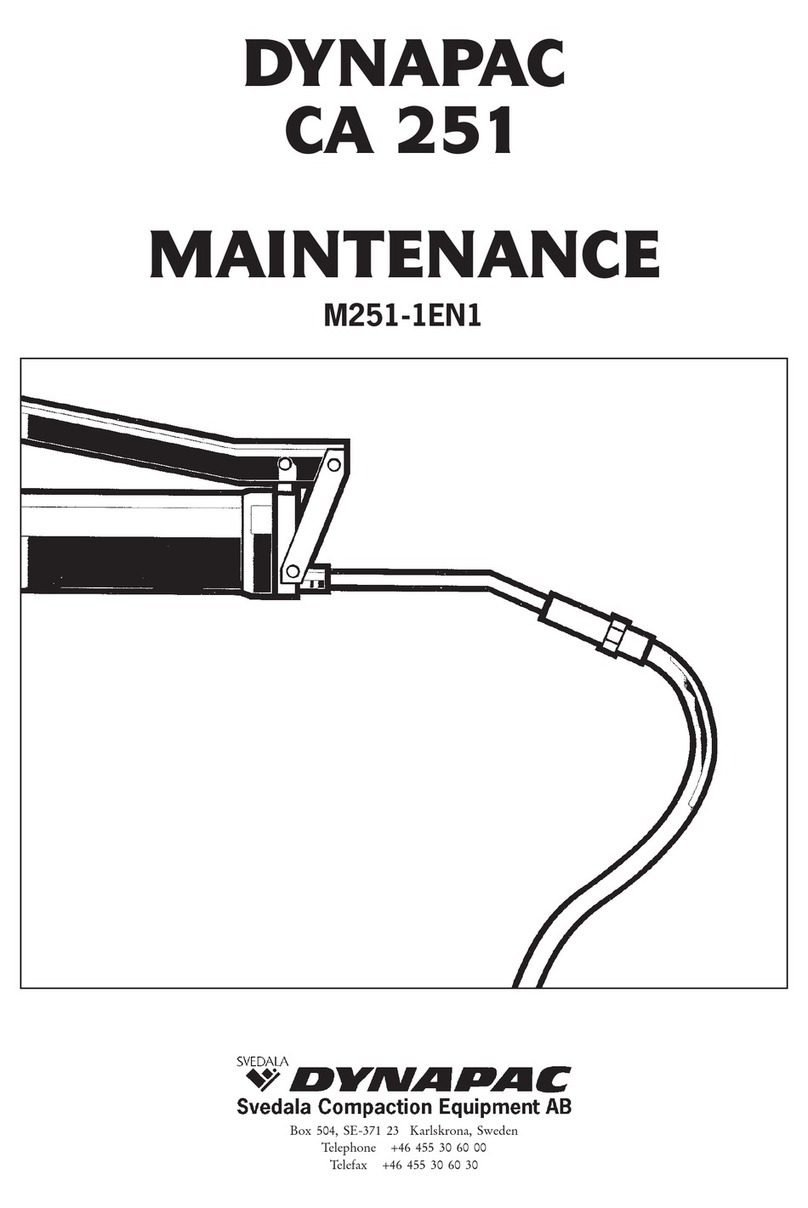
Dynapac
Dynapac CA 251 Maintenance manual
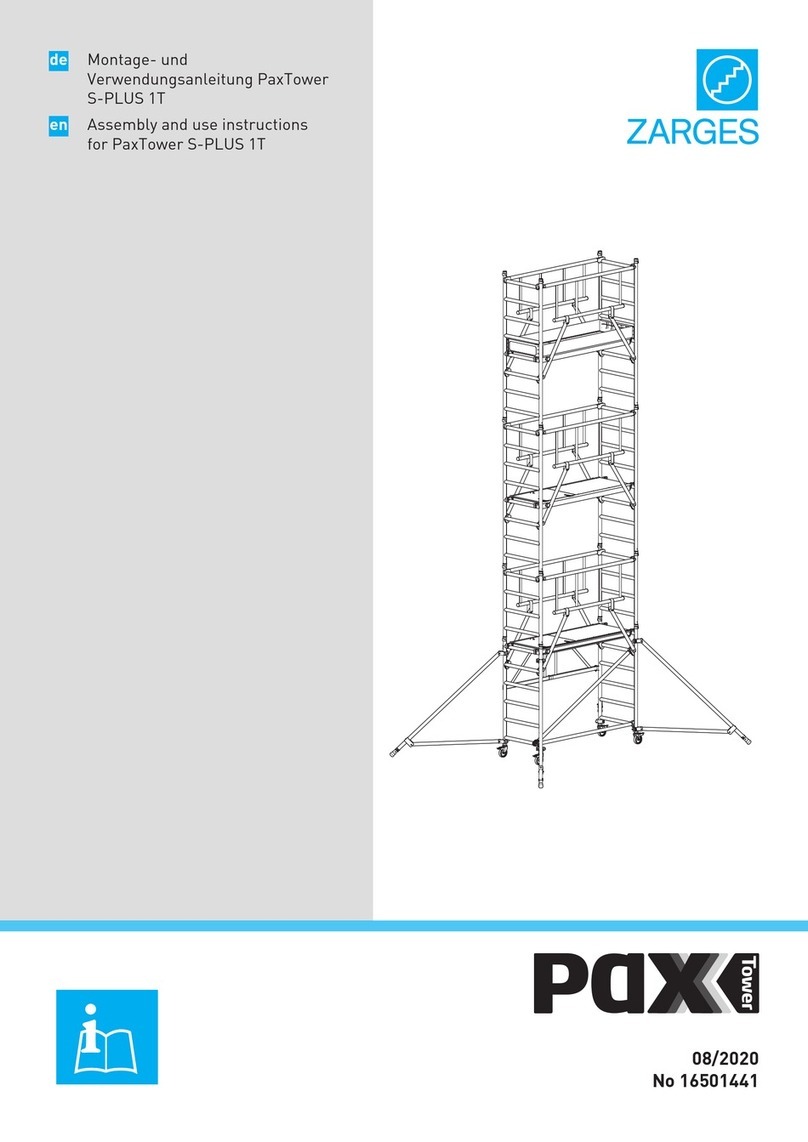
zarges
zarges PaxTower S-PLUS 1T Assembly and use instructions
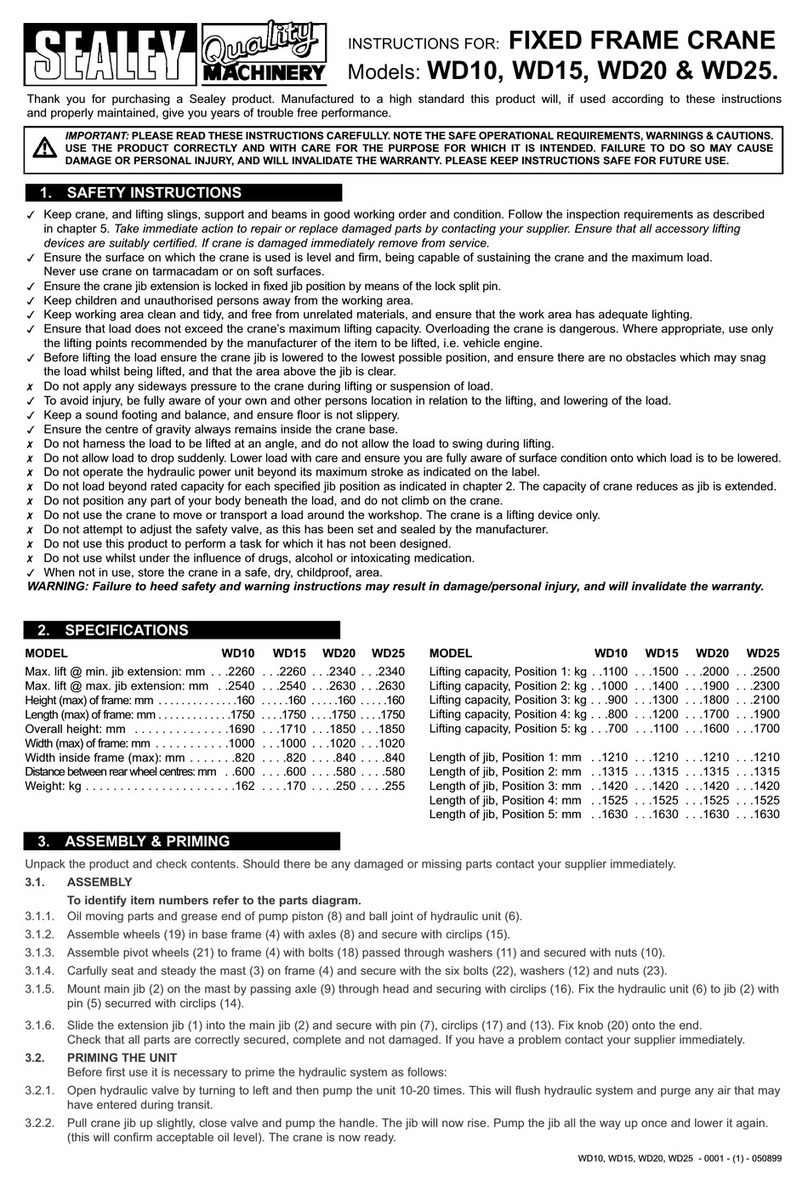
Sealey
Sealey WD10 instructions
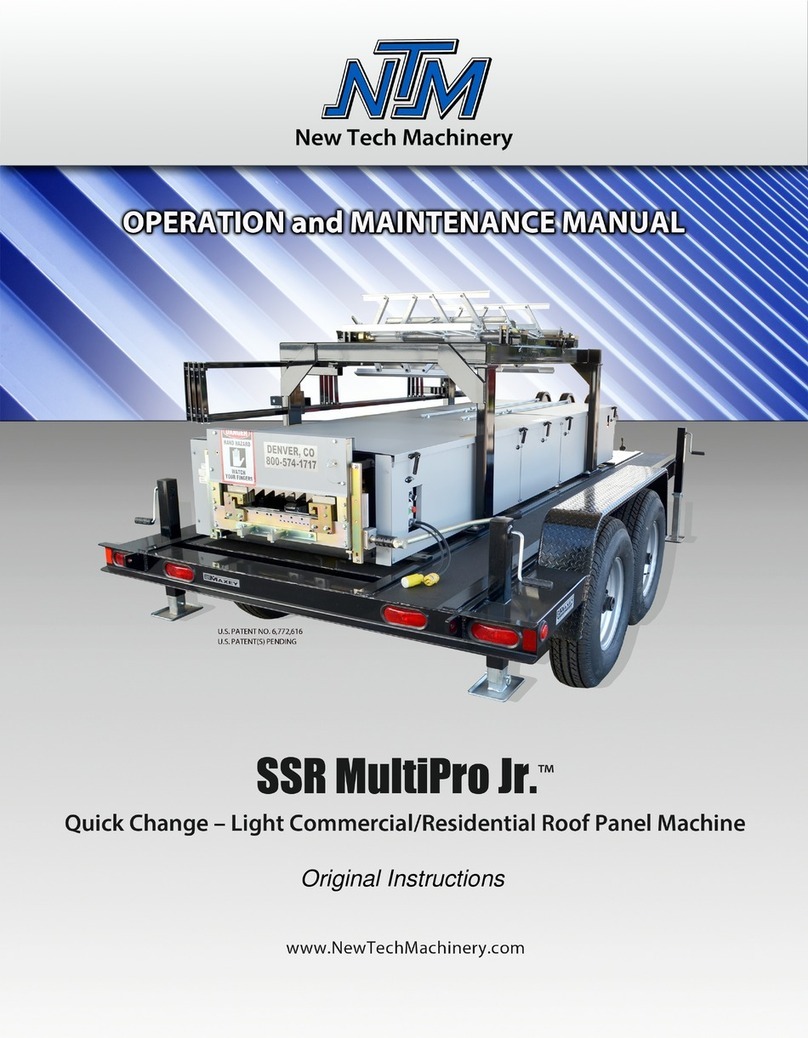
NTM
NTM SSR multiPro Jr Operation and maintenance manual
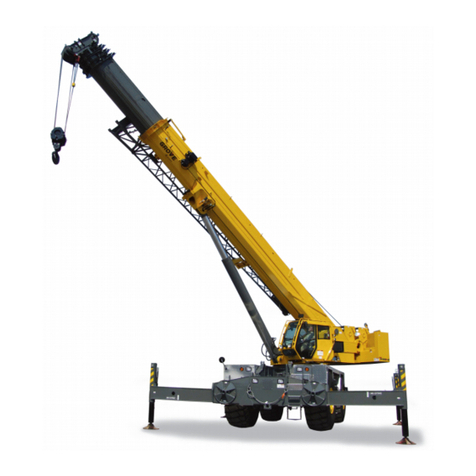
Manitowoc
Manitowoc Grove RT9130E-2 Service and maintenance manual
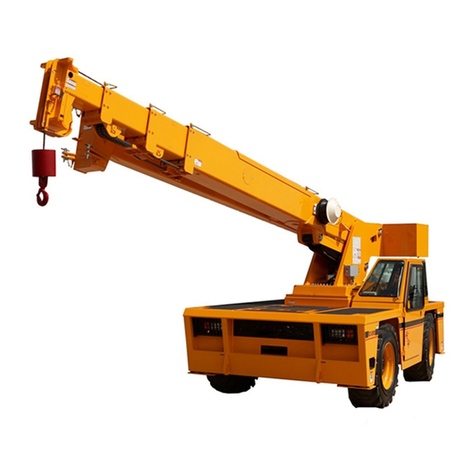
Broderson
Broderson IC-200-2J Operation and maintenance manual
